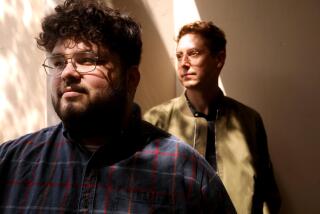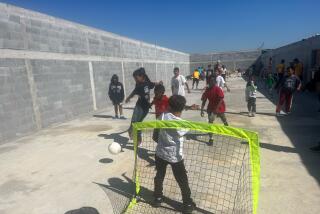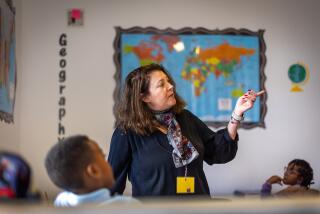Playing Safe: a Lesson for Latchkey Children
- Share via
ALHAMBRA — The Red Cross volunteer stood in the classroom, talking to a group of 7- and 8-year-olds about coping with the problems of being alone.
At least two-thirds of the 60 Ramona School second- and third-graders raised their hands when asked if they regularly come home to an empty house. And nearly all of the children said they have been left home alone for as long as an hour.
“There are times we have to think for ourselves because nobody else is there,” the volunteer, Doris Blackstock, told the children.
“You have to know what to do to take care of yourselves.”
While society wrestles with the long-range problem of care for latchkey children--those who are home alone after school because their parents work--the West San Gabriel Valley chapter of the American Red Cross is dealing with the more immediate problem of how to make latchkey children safer and more self-reliant.
The seriousness of the problem became apparent last spring when a latchkey child who lived in the area opened the door to a stranger who raped her, said Dennis Brakeman, director of the West San Gabriel Valley chapter of the Red Cross. The Red Cross, which had been preparing a program aimed at acquainting latchkey children with ways to cope with being home alone, responded by starting its new “Home Alone” program ahead of schedule.
The program, which had been scheduled to start this fall, was presented to 1,500 students before the school year ended. It includes a short film and a supplementary educational game book. Volunteers visit schools and show the film, following up with a list of safety tips. Their recommendations to the children include:
- When walking home from school, never get into a car with anybody.
- If you carry a house key, don’t play with it or let people see it.
- Lock the door at home.
- Don’t open the door to anyone, even if you know the person.
- If the phone rings, never say that you’re home alone.
- If there is a fire, leave the house. Don’t try to put it out.
- Call 911 for all emergencies.
Brakeman, who is coordinating the program, said an estimated one-third of all elementary school-age children have to care for themselves after school.
At the recent presentation at Ramona School, volunteer Blackstock showed the film, which points out the dangers of leaving children at home and touches on the fears they face and how to deal with them.
Blackstock then went over the book with them, emphasizing the dangers of talking to strangers.
“Bad people don’t always look bad,” she told them.
“People asking you to get in their car may look safe, but you should run away from them,” she said. “There was one case when the driver of the car wanted to show a child a puppy. The child went to the car to see and the man took her. We don’t want that to happen to you, so don’t get in the car, even if you know the person.”
The children sat quietly, watching the film, which has been criticized by both teachers and older students because the “stars” in it look and act too good to be true. Siblings in the film get along much better than brothers and sisters in real life and their behavior is abnormally perfect, the critics say.
“I wish we had two films, one for the younger children and one for the older ones,” Blackstock said.
“The film is better for grades 2 through 4,” said Assistant Principal Harold Vences. “Kindergartners are too young and the fifth- and sixth-graders don’t think they need it.
“But this program is very helpful to the children. We really need this kind of thing in our school. The parents try to do their best but so many work and they have to leave their kids alone a lot.
“The teachers will repeat the information during the year to reinforce it with the children. Every little bit helps,” he said.
Teacher Marlys Carusone, who sat through the program for the first time with her students, said she thought it was excellent because it touched on a number of areas that parents might not think to discuss with their children, including keeping a list of names and phone numbers of relatives and neighbors handy where children can easily find it.
“All the children were very interested in the program and I think they got something out of it,” she said. “Later in the day we talked about it and they wanted to talk about the times they were home alone. It is something most of them face.
“The day after the program I again went over the book with them to reinforce it.”
Carusone agreed with Blackstock and Vences that the film is most suitable for younger children, but said the program made a definite impression on her students.
The program was developed by the Red Cross in Kansas City and is also used in Santa Barbara.
The West San Gabriel Valley Chapter of the Red Cross hopes to present it to all elementary school children in the 74 schools in its district, which includes El Monte, Monterey Park, Rosemead, San Gabriel and South El Monte, Brakeman said.
However, Brakeman said, it will take a while. He said the Red Cross has 10 volunteers but only one copy of the film.
More to Read
Sign up for Essential California
The most important California stories and recommendations in your inbox every morning.
You may occasionally receive promotional content from the Los Angeles Times.










